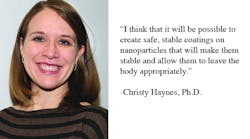Nanoparticles – engineered materials that measure one-billionth of a meter or smaller – can be found in hundreds of consumer products, including food, lotions, cosmetics and more. But according to one expert, some of the research conducted to determine the health and environmental safety impact of nanomaterials may have yielded misleading results.
During a lecture at the American Chemical Society (ACS) national meeting earlier this month, Christy Haynes, Ph.D., principal investigator of The Haynes Research Group at the University of Minnesota, explained that more than 800 consumer products based on nanotechnology are on the market. A new field, “nanotoxicology,” emerged in the last decade to investigate those concerns.
“Initial work focused on using the toxicology tests that had been used for years to evaluate bulk materials,” Haynes said. “Nanoparticles, however, are inherently different. A nanoparticle of material used in food or a cosmetic lotion may contain just a few atoms, or a few thousand atoms. Regular-sized pieces of that same material might contain billions of atoms. That difference makes nanoparticles behave differently than their bulk counterparts.”
Size Matters
A 1-ounce nugget of pure gold has the same chemical and physical properties as a 2-ounce nugget or a 27-pound gold bar. But for nanoparticles, size often dictates the physical and chemical properties, and those properties change as the size decreases.
Haynes said that some of the earlier nanotoxicology tests did not fully take those and other factors into account when evaluating the effects of nanoparticles. In some cases, the bottom line in those tests was whether cells growing in laboratory cultures lived or died after exposure to a nanoparticle.
“While these results can be useful, there are two important limitations,” Haynes explained. “A cell can be alive but unable to function properly, and it would not be apparent in those tests. In addition, the nature of nanoparticles – they’re more highly reactive – can cause ‘false positives’ in these assays.”
Haynes described a new approach used in her team’s work in evaluating the toxicity of nanoparticles. It focuses on monitoring how exposure to nanoparticles affects a cell’s ability to function normally, rather than just its ability to survive the exposure. In addition, they have implemented measures to reduce “false-positive” test results, which overestimate nanoparticle toxicity
“So far, we have found that nanoparticles made of silver or titanium may be the most problematic, though I would say that neither is as bad as some of the alarmist media speculations, especially when they are stabilized appropriately,” said Haynes. “I think that it will be possible to create safe, stable coatings on nanoparticles that will make them stable and allow them to leave the body appropriately. We need more research, of course, in order to make informed decisions.”

